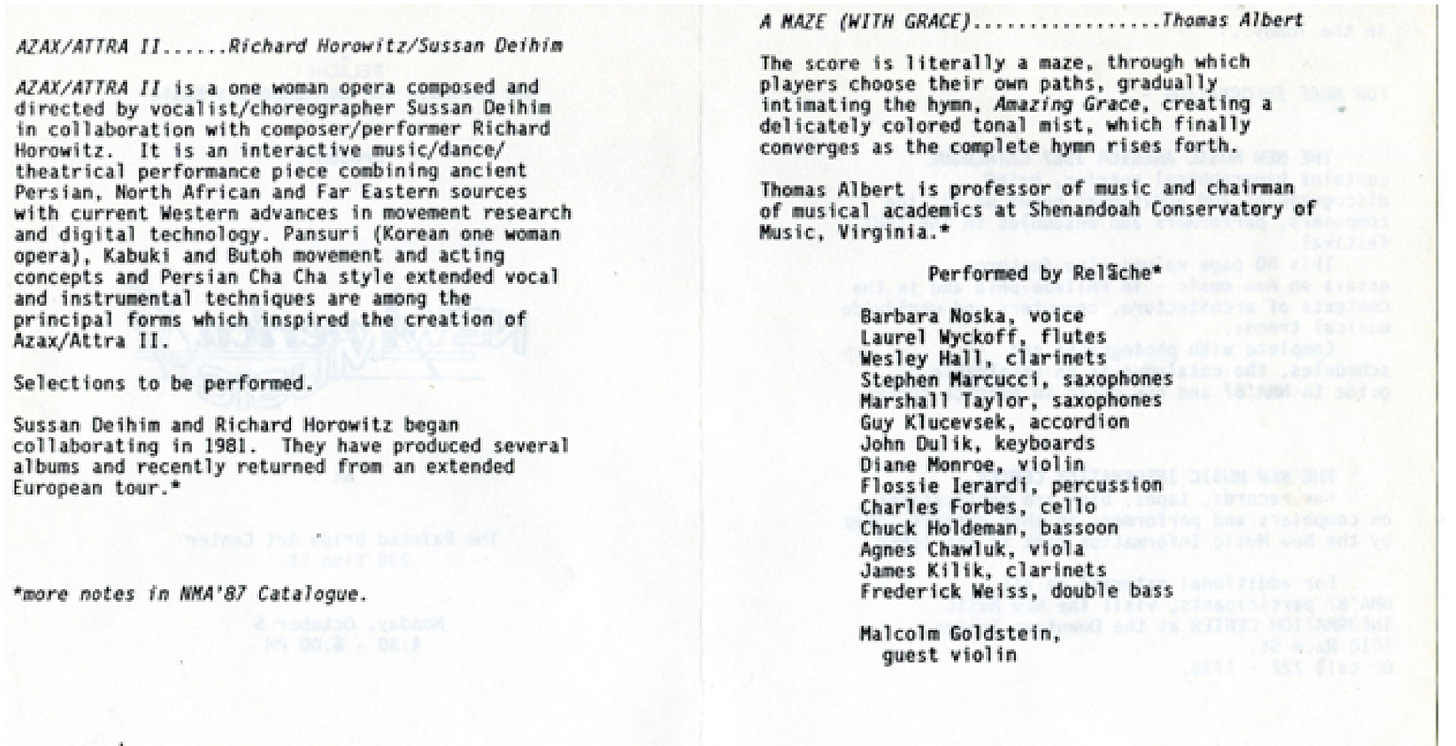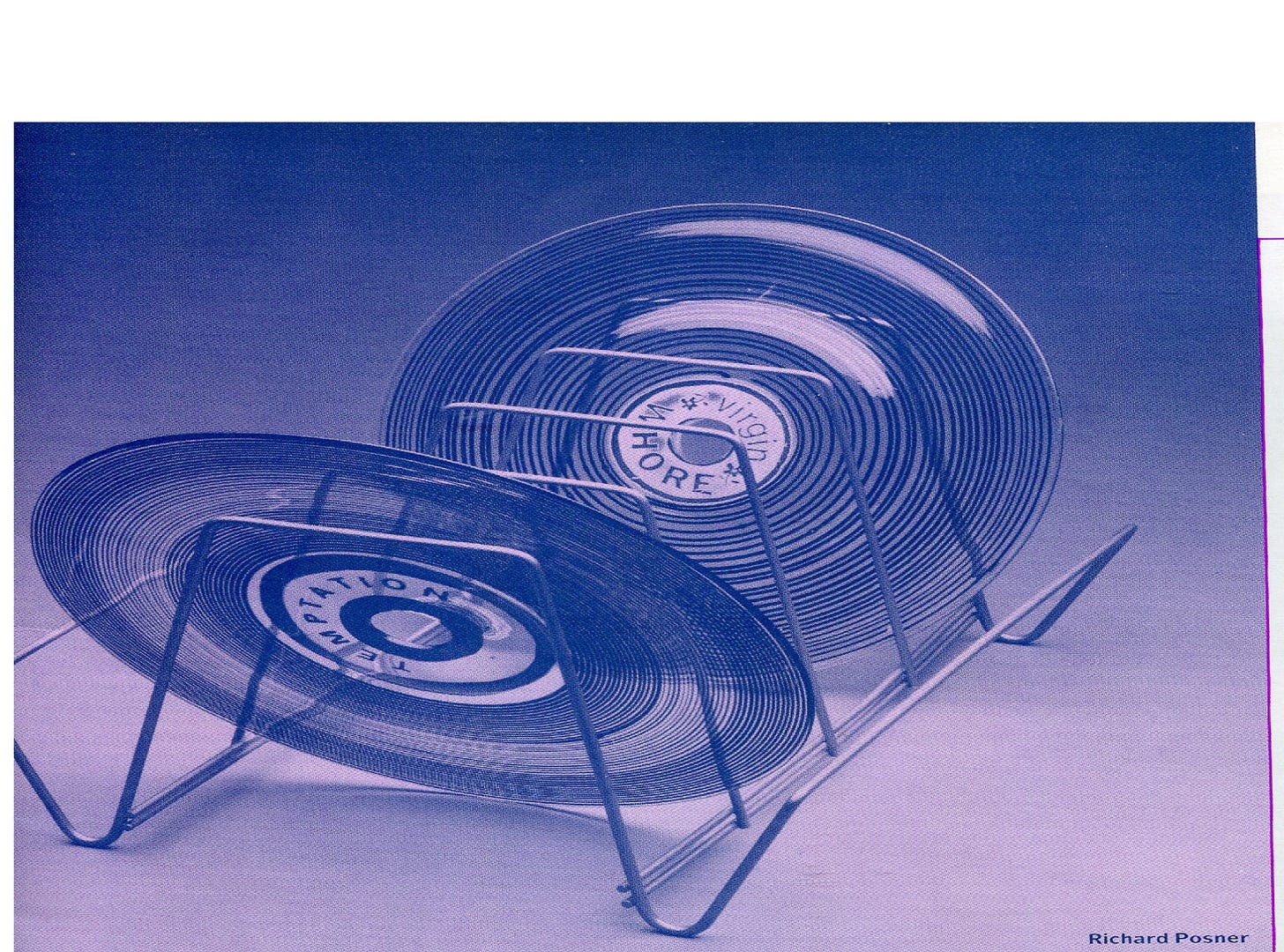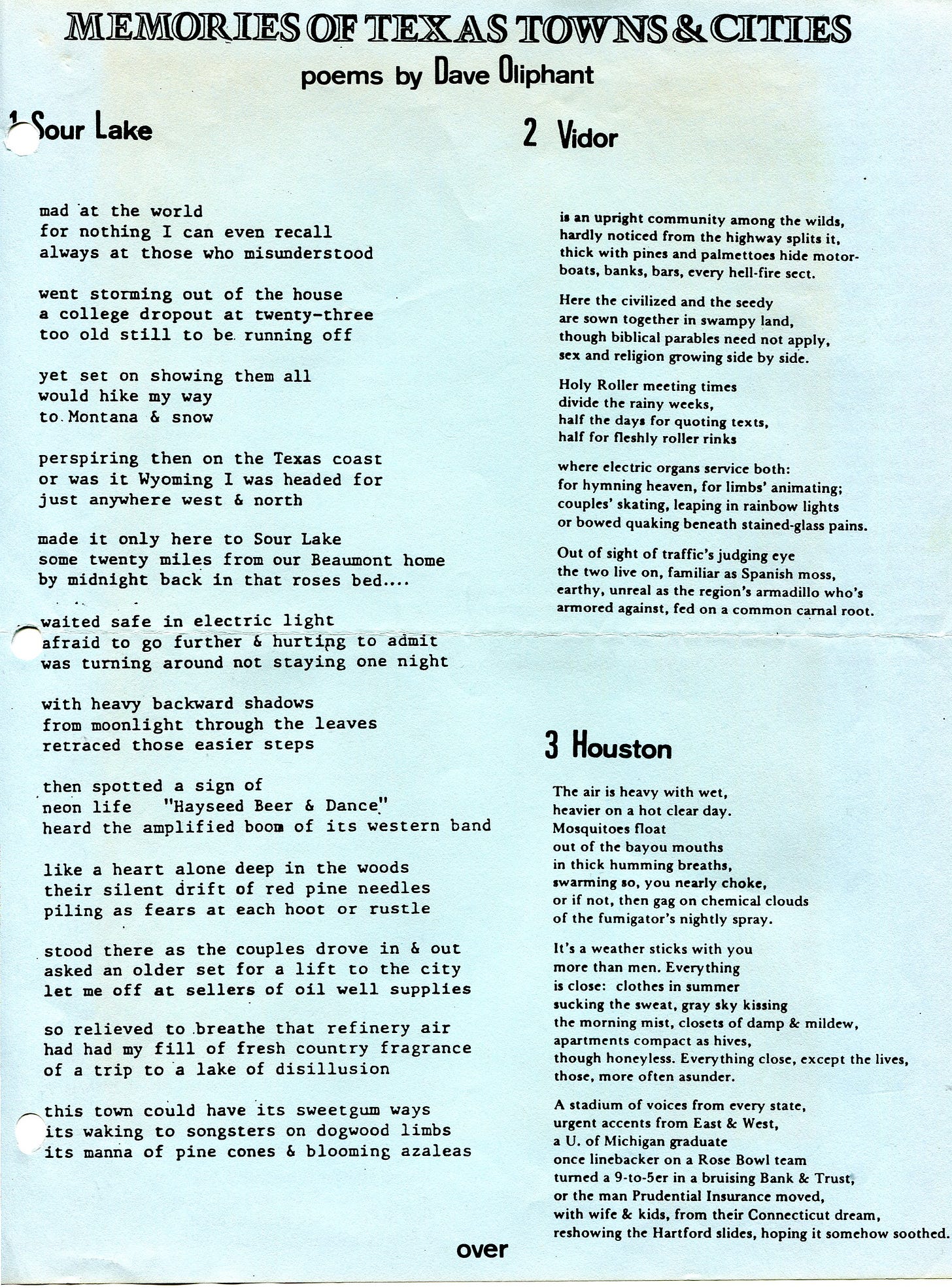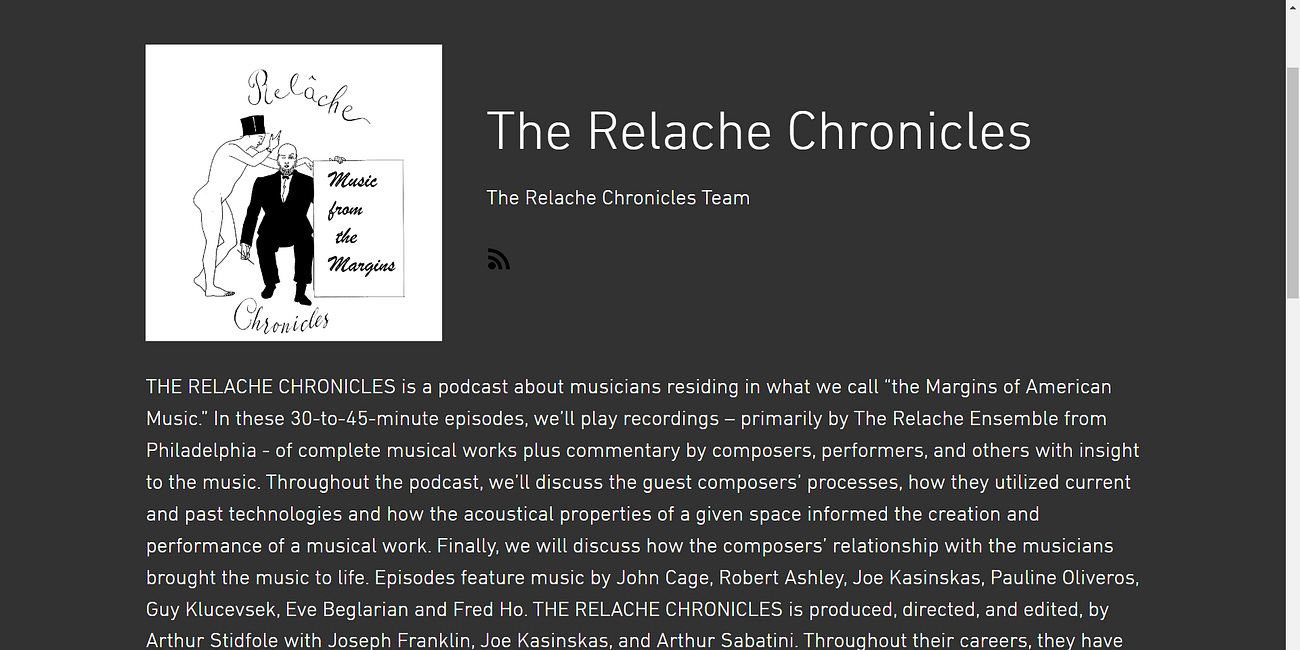October 5, 1987 NMA Philadelphia day 4
Margaret Leng-Tan, Ge Gan-Ru, Toshi Ichiyanagi, Yori-Aki Matsudaira, Somei Satoh, Deyhim-Horowitz, Relâche, T. Albert, L. Montano, R.Possner, Penn Contemp. Players, Borah Bergman, HMP Trio, A. Rudin
Sussan Deyhim and Richard Horowitz from the recording of what they played live on this date (see below for link to full performance audio):
New Music Alliance Meeting 1
Good Sound Foundation demonstrations and lecture
Margaret Leng-Tan, Piano Recital
Ge Gan-Ru: Gu Yue (Ancient Music); Somei Satoh: A Gate Into The Stars / Litania; Toshi Ichiyanagi: Piano Media; Yori-Aki Matsudaira: Resonance
“New Music and Theatre” lecture and panel discussion
Richard Horowitz and Sussan Deyhim - Azax/Attra II
Relâche - Thomas Albert: A Maze (With Grace)
Linda Montano Casio Portraits
Richard Posner Pro American Bandstand
Penn Contemporary Players, Richard Wernick, Conductor: Wernick – “Introits & Canons”
Borah Bergham, piano – Upside Down Visions
The HMP Trio – Lawrence Butch Morris, Wayne Horvitz and Bobby Previte
Relâche: Andrew Rudin – Memories of Texas Towns and Cities
================================================
New Music Alliance Meetings 1
gd note - for your convenience and putting it in the right place in the space-time continuum, I re-insert that day’s New Music Alliance sessions - I was the recording secretary for these public meetings - but I have already transcribed the first four days with two more transcriptions to come later on this year. This is one of the sessions with the Quality Inn buzzsaws adding their own sonic disruptions. Go to my September 22 post for the transcription to this one, link at the bottom of the page. Roll call: Michael Galbreth (chair), Yale Evelev, Jerry McCathern, Roger Page, David Moss, Stewart Boesalager, Georges Dupuis, Patrick Darby, Brian Johnson, Steve Cellum, Ray Gallon. Yup, no women.
New Music Alliance, October 5, 1987, part 1
New Music Alliance meeting part 2
New Music Alliance meeting part 3
================================================================
Good Sound Foundation demonstration and lecture
My recording from the hall, nowhere as good a sound as the one these people offered to the festival. Funniest thing is hearing how they had to deal with Borbotemagus! (I’m not 100% sure whether this was recorded on October 3 or 5.)
Excerpt from lecture, part 1
Lecture, part 2
♪ ♪ ♪ ♪ ♪ ♪ ♪ ♪ ♪ ♪ ♪ ♪ ♪ ♪ ♪ ♪ ♪ ♪ ♪ ♪ ♪ ♪ ♪ ♪
Margaret Leng-Tan at the Philadelphia Ethical Society
(see separate posting today for way more detail including an interview she made at the time with Augusta LaPaix)
Performance recording from Other Musics/Relâche (not including Litania)
https://archive.org/details/NMA_1987_10_05_1_c1
==============================================
Herbert Blau, lecture; panel with Don Shewey, Arthur Sabatini, and Roger Oliver
Schubert Theatre, Philadelphia College of the Arts
“New Music and the Theatre” lecture and panel discussion
My recording from the audience of this session, part 1
Part 2:
1630-1800 Painted Bride
Richard Horowitz and Sussan Deyhim - “Azax/Attra II”
Actual performance recording in five parts begins here:
https://archive.org/details/NMA_1987_10_05_2_c1/C05-02_Richard_Horowitz_and_Susan_Deyhim_Part_1.wav
Other Minds/Relâche archive.org notes:
This is followed by a lengthy set of mostly unidentified works by Richard Horowitz and the Iranian vocalist and composer Sussan Deyhim. These feature syncopated beats with sounds of flutes, bass guitar, and other sundry aural elements all of which serve as the tapestry over which Deyhim lays down a wide variety of breathy chants and vocalizations. While more world beat than typical 20th century classical music, and perhaps thus a bit of a deviation from New Music America Festival's typical fare, there is no doubting the energy and spirit that went into this remarkable performance. While versions of some of the works heard here were later released on their 1987 album Desert Equations: Azax Attra, others appear to be either extended improvisations or radically different versions than those later commercially released. Either way this concert is a rare live performance by two early progenitors of world fusion. tribal beat music.
*
One of the most fascinating performing duos I have ever seen, this was a prelude to the killer performance at the BAM two years ago. Her screeches were all the more awesome given her Iranian background and the current fear at the time of Iran and all of that tyranny. And at the Painted Bride, it turned out to be a very intimate affair. Later, I was to serve her tea in our hotel room as she was the guest to the two Good Sound Foundation guys. What a pleasure to meet such a graceful performer, both on and off the stage.
- gd notes written in 1987
==================================
Program notes for above and below:
♪
Relâche - Thomas Albert: A Maze (With Grace)
https://archive.org/details/NMA_1987_10_05_2_c1/C05-01_A_Maze_With_Grace_Thomas_Albert.wav
Relâche/Other Minds description:
The fifth concert of NMA '87 began with musical chamber ensemble Relâche performing Thomas Albert's A Maze (With Grace), a 1975 composition in which the American composer incorporates themes from the well known song into a more sedate sonority of resonant extended notes and atmospheric vocals.
*
Albert's A Maze (With Grace) was a decade-old meditation piece fashioned quite logically from the hymn embedded in its title.
- Kyle Gann, "Quiet Heroics", Village Voice November 10, 1987
♪
1800-1900 Painted Bride – exhibit opening
Linda Montano – Casio Portraits
Linda Montano played Casio Portraits by channeling people's vibes; mine, at least, was uncannily insightful.
- Kyle Gann, "Quiet Heroics", Village Voice November 10, 1987
*
gd memory: As part of the work, she interviewed me and I would have to say that my ego in the context of a NMA artist asking me personal questions like “Who would you like to be in any time?” remembers that part but not the musical component. I answered, “Me, now, because I’m really enjoying myself here.”
♪
Richard Posner – Pro American Bandstand
Program notes:
In Philadelphia and across the nation, Americans lift their glasses in a toast to 1987, the 200th anniversary of the Constitution of the United States.
This year also marks the 30th anniversary of the American Bandstand television program.
A coincidence which conjures up visions of Dick Clark, the Dorian Gray of American culture, spinning patriotic platters from a Hit Parade review stand - while fresh generations of boys and girls are encouraged to march, mambo and hully gully off to war.
Pro American Bandstand is a collection of transparent war records - glass LPs based on a read hearing (The Winter Soldier Investigation), about a novel idea (the journey some vets make from being agents and victims of violence, to becoming teachers who foster healing and reconciliation) - in the aftermath of the Vietnam War.
- Richard Posner - installed at the Painted Bride Art Center
2030-2230 Port of History Auditorium
Penn Contemporary Players, Richard Wernick, Conductor -
George Crumb: Songs, Drones and Refrains of Death
Performed by Inner Pulse Ensemble in this video:
George Crumb’s music has also profited from extended piano techniques. During a New Music America program at the Port of History yesterday evening, some of his moody piano effects could be heard in the Philadelphian’s fine Songs, Drones and Refrains of Death, from 1969. It was given a stirring reading by the Penn Contemporary Players under able conductor Richard Wernick. Wernick’s rather intellectual Introits and Canons was also part of the program.
- gd - I seem to have misplaced the clipping that tells me who wrote this!
♪
Richard Wernick: Introits & Canons
Program notes:
Contrapunctus I - Introit I: Maestoso; Canons I: (with isorhythm); Canons II
Contrapunctus II - Introit II: Maestoso; Chaconne (canons III);
Contrapunctus III; Introit III: (Scherzo); Passacaglia: Reprises and Reminisences (Canons IV); Recessional: Maestoso
Introits and Canons is a series of extended and developed canons, connected by a recurring homophobic motif (or Introit). It is essentially a contemporary view of baroque forms and consists of a number of 20th century variances of polyphonic music.
Relâche did its civic duty by programming local profs George Crumb and Richard Wernick plus a piece by younger academic Melinda Wagner that sounded like the Reader's Digest version of Berg's Three Pieces for Orchestra. The audiences for these works cheered lustily and left at intermission, and Wernick later conceded that Crumb is the country's most oft-performed composer.
- Kyle Gann, "Quiet Heroics", Village Voice November 10, 1987
♪
Borah Bergham, piano: Upside Down Vision
preview article in the Philadelphia Inquirer by Francis Davis
Based on the principles of ambidexterity, the "split" brain and the ability to create independent "left" and "right" ideas simultaneously. Comprovisation - a word I coined in 1981 describing the synthesis of composition and improvisation.
- Borah Bergman
Upside Down Vision
https://archive.org/details/NMA_1987_10_05_3_c1/C06-09_Upside_Down_Visions_Borah_Bergman.wav
Spirit Song
https://archive.org/details/NMA_1987_10_05_3_c1/C06-10_Spirit_Song_Borah_Bergman.wav
♪
The HMP Trio – Lawrence “Butch” Morris, Wayne Horvitz and Bobby Previte
https://archive.org/details/NMA_1987_10_05_3_c1/C06-04_New_Works_Part_1_HMP_Trio.wav
Other Minds/Relâche archive post at the link - program notes:
The HMP Trio had performed in New York since 1983. Led by composer and keyboardist Wayne Horvitz, the Trio utilizes compositions which emphasize organic interaction between thematic, harmonic and structural elements with improvisation. Besides the primary instrumentation of cornet, piano and percussion all three members play a variety of computer based electronic instruments, keyboards and mallet instruments. The aggressive percussion style of Robert Previte and the introspective lyricism of cornetist Butch Morris bring a fragile intensity to the music. Their debut album, "Nine Below Zero," was released in January 1987.
The title track from that album:
Joseph Franklin: HMP Trio was comprised of Bobby Previte, Wayne Horvitz and Butch Morris. Three, three really fine, ah, instrumentalists and composers. Each of those guys brings a strong background in improvisational music and playing in varieties of new music ensembles from that period. Each of them wrote a lot of material. Much of their musical life has been as side men.
20:15 ● It’s a tri-fold thing. They’re – they’re composer-performer-listeners. So a lot of what you hear in that group…
20:21 ● …a key thing about that is that so many of the musicians on New Music America were drawing on such different traditions. And such different performance styles. And different ways of combining musical material.
- Joseph Franklin, The Relâche Chronicles
♪
Relâche: Andrew Rudin – “Memories of Texas Towns and Cities”
(Sept 22) New Music Alliance: the public meeting transcripts - 1987 Philadelphia day 1/6
Michael Galbreth, Board Chair during the 1987 New Music Alliance meetings. Photo cribbed from the Glasstire website where they published this nice tribute upon Michael’s passing in 2019, credited to Molly Glentzer of the Houston Chronicle, the obituary written by Christina Rees
The episode from which Joseph Franklin’s quote came from (the full episode is transcribed):
(Sept 6) Fresh off the stream! The Relâche Chronicles #9 - NMA 1987 Philadelphia 1/3
The Relâche Chronicles, August 8, 2023 Episode Nine - New Music America 1987 (1/3) transcribed hastily* by Georges DupuisTales of the Chief Describer is a reader-supported publication. To receive new posts and support my work, consider becoming a free or paid subscriber.






















